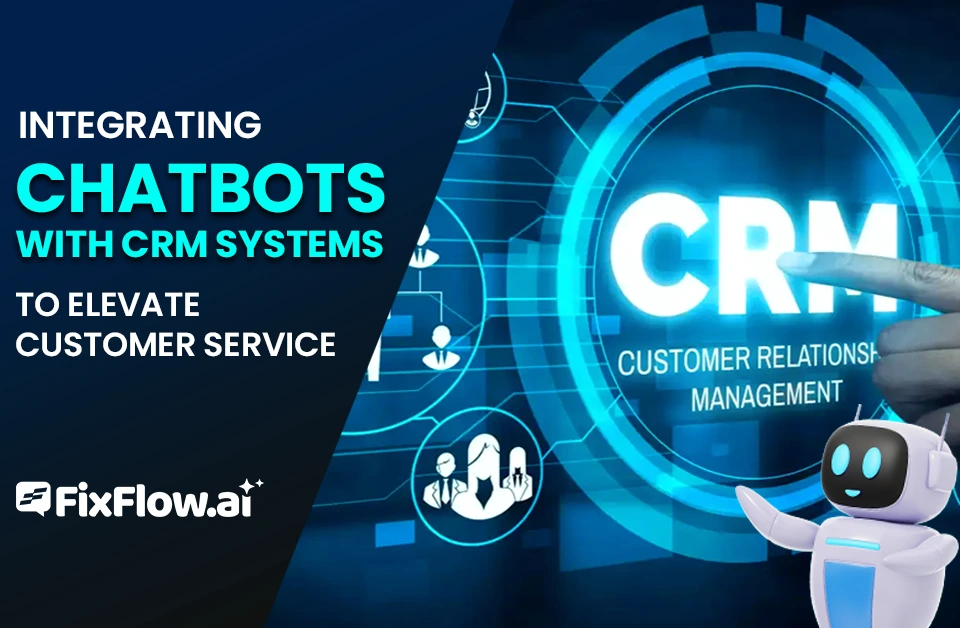Integrating Chatbots With CRM Systems to Elevate Customer Service
Integrating chatbots with CRM systems can elevate customer service by automating routine inquiries, giving your team time to tackle complex issues. This integration ensures that customer data is synchronized and up-to-date, allowing personalized interactions that boost satisfaction and loyalty. Automating workflows will reduce the time spent on mundane tasks, improving team efficiency. With natural language processing and real-time updates, chatbots provide engaging, accurate interactions while ensuring data security remains a priority. Although integration challenges like data privacy and system compatibility exist, these can be managed effectively. For insights into future trends and innovations, continue further.
Benefits of Chatbot-CRM Integration
Integrating chatbots with CRM systems enhances customer support operations in many ways. One of the most significant benefits is the creation of automated responses to common inquiries. This allows your team to focus on more complex issues, boosting efficiency. Additionally, data synchronization ensures that all customer information is up-to-date and accurate across different platforms, minimizing errors and redundant data entries.
Personalization is another key benefit you’ll enjoy. By integrating chatbots with CRM systems, you can tailor interactions based on detailed customer data. This personalized approach increases user satisfaction and strengthens customer loyalty, as clients feel valued and understood. Furthermore, workflow automation streamlines processes, reducing the time spent on repetitive tasks and allowing your support team to work more effectively.
Ultimately, this integration leads to a more seamless communication experience for customers. When chatbots and CRM systems work together, you’re enhancing the overall quality of service delivery. The result? Happier customers and a more efficient support operation. By embracing this technology, you’re not just keeping up with the times—you’re setting a new standard in customer service excellence.
Implementing Chatbots in CRM
Implementing chatbots in CRM systems is a strategic move that can significantly transform your customer support operations. Incorporating natural language processing will enable your chatbots to understand and respond to customer inquiries more effectively. This makes interactions feel more human-like and enhances the overall customer experience. With strong customer data management, chatbots can access and utilize information from your CRM, allowing for more personalized and relevant interactions.
Seamless communication between your chatbots and CRM ensures that all customer interactions are synchronized and recorded, providing a comprehensive view of each customer’s history. This integration reduces the chances of miscommunication and ensures every agent or automated system has the same information.
When implementing chatbots in CRM, data security must be a top priority. This includes protecting sensitive customer data, ensuring compliance with privacy regulations, and maintaining customer trust. An intuitive user interface is also essential for a smooth interaction experience. A well-designed UI makes it easy for customers to engage with your chatbots, improving satisfaction and efficiency. By integrating these elements, you can improve customer service and streamline operations.
Enhancing Customer Interactions
Implementing chatbots in CRM systems lays a solid foundation for streamlined operations, and the real magic happens when you enhance customer interactions. By leveraging natural language processing, chatbots understand and respond to customer inquiries more effectively, making interactions feel less robotic and more engaging. This technology allows chatbots to interpret customer intent, fostering a more personalized experience.
Integrating these intelligent bots with your CRM system ensures you have up-to-date customer profiles at your fingertips. Chatbots can pull relevant information from these profiles, offering tailored responses that resonate with each customer. No more generic replies—your customers will appreciate the personalized touch.
Real-time updates are another game-changer. Your CRM is instantly updated as customer data changes, ensuring your chatbot has the latest information. This leads to more accurate and meaningful interactions, boosting customer satisfaction.
Don’t underestimate the power of a well-designed user interface. A seamless interface makes it easy for customers to navigate interactions, keeping them engaged and satisfied. Enhancing customer interactions is not just about using technology—it’s about transforming your customer service into an experience that customers will remember and value.
Overcoming Integration Challenges
How do you successfully tackle the challenges of integrating chatbots into CRM systems? First, it is crucial to address integration complexity. You must collaborate with your IT team to ensure the chatbot can seamlessly communicate with your CRM and understand data flows and interactions. This often involves API integration, which must be meticulously mapped to prevent disruptions.
Next, data privacy and user authentication cannot be overlooked. With sensitive customer information at stake, implementing robust security measures is essential. Ensure the chatbot and CRM systems comply with relevant data protection regulations. This includes encrypting data transfers and using secure authentication methods to verify user identities.
System compatibility is another hurdle. Your chatbot must be compatible with existing CRM infrastructure. Conduct thorough integration testing to confirm the systems work harmoniously, minimizing potential errors. Speaking of mistakes, error handling should be proactive. Design your chatbot to identify and address errors swiftly, providing users with clear guidance when things don’t go as planned.
Finally, addressing these challenges will lead to a smoother integration process, significantly enhancing customer service capabilities. This strategic approach ensures a seamless experience for your team and customers.
Future Trends and Innovations
After tackling the integration challenges, looking at future trends and innovations in chatbot and CRM integration is exciting. Imagine a world where AI advancements make chatbots smarter, more intuitive, and capable of understanding complex customer queries. With predictive analytics, you’ll be able to anticipate customer needs before they even reach out, allowing for proactive engagement and a truly personalized experience.
Cross-channel support is another trend transforming the landscape. You’ll no longer be confined to a single platform; your chatbot will seamlessly interact with customers across multiple channels, such asal media, email, or messaging apps. This integration ensures that your service is consistent and efficient no matter where your customers are.
Scalability is key in adapting to the growing demands of your business. By training your chatbots effectively, you ensure they can handle increased volumes of customer interactions without compromising quality. This scalability allows your customer service to grow with your business, providing top-notch support at every stage. As these innovations unfold, you’ll find that integrating chatbots with CRM systems opens new doors to elevate customer service to unprecedented heights.
Frequently Asked Questions
How Do Chatbots Handle Multi-Language Support in CRM Systems?
Chatbots use Natural Language Processing (NLP) to understand and respond in different languages when dealing with multi-language support in CRM systems. They’re often equipped with translation capabilities to ensure seamless communication. You can configure them to detect a customer’s preferred language and switch automatically. This helps maintain personalized and efficient interactions, ensuring customers feel understood and valued regardless of language.
What Are the Initial Steps to Start Chatbot-Crm Integration?
First, assess your business needs and objectives to kick off your chatbot-CRM integration. Identify your CRM system and ensure it has the necessary API support. Next, choose a compatible chatbot platform that aligns with your goals. Set up authentication protocols to secure data exchange. Then, map out workflows and define clear use cases. Finally, the integration will be tested to ensure seamless functionality and address compatibility issues.
How Do Chatbots Gather and Update CRM Customer Data?
You might wonder how chatbots gather and update CRM customer data. Well, they use natural language processing to understand customer queries and interactions. As a customer engages with the chatbot, it collects information and updates the CRM in real time. This ensures that all interactions are recorded, providing a comprehensive view of customer history. By doing so, chatbots help ensure your data is accurate and up-to-date, enhancing customer service efficiency.
What Industries Benefit Most From Chatbot-Crm Integration?
You might wonder which industries gain the most from integrating chatbots with CRM systems. Retail, finance, and healthcare are top contenders. In retail, chatbots can streamline customer inquiries and personalize shopping experiences. In finance, they enhance service delivery and transaction management. Healthcare benefits by efficiently managing patient interactions and appointment scheduling. Integrating these systems will elevate service and improve operational efficiency across various sectors.
Can Chatbots Operate Offline Within CRM Systems?
You might wonder if chatbots can function offline within CRM systems. Generally, chatbots require an internet connection to access real-time data and provide updated responses. Offline operation is limited; without connectivity, they can’t pull or synchronize data from the CRM database. They might perform basic tasks or use cached information, but an active connection is necessary for optimal functionality to ensure seamless service and up-to-date interactions.







